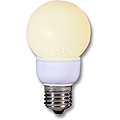An LED Lamp or Light Emitting Diode Lamp, uses solid-state technology to illuminate, rather than a filament or gas. Unlike Incandescent or Compact Fluorescent Lamps (CFL), LED Lamps very small and consume very little energy. In most cases even the brightest individual LED does not equate to a standard-sized 100W Incandescent or CFL equivalent (~20W). Thus in an LED bulb usually clusters of 3-18 individual LEDs are used to simulate the equivalent in an Incandescent or CFL. Where this might seem like a great number to include in a lamp, each LED consumes barely more than 1/20th of a Watt (~49 mW or milliwatts)
History
Discovered in the 1960s, diodes have been used on countless millions of electronic devices. Compared to most alternate technologies such as Neon or miniature filament lamps, LEDs were often too low on voltage and brightness to be considered useful as a normal household lamp. Although where these more traditional technologies were readily available, their longevity and power efficiency were often poor by comparison to LEDs.
Initially, LEDs were only produced in Red as the technology had not advanced to the capability of producing colors with shorter wavelengths. Later with finer degrees of production other colors in the spectrum would become available, such as Orange, Yellow, and Green. Not until the early 1990's would Blue, Violet, and Ultra-violet become available. In 1993, through the use of Gallium Nitride (GaN) would a white LED be made possible, which in turn would make LEDs available for use in the home today.
Cost Comparison

| 60W Incandescent | 2W LED | |
|---|---|---|
| Life Span (hrs) | 1,000 | 30,000 |
| Num. Bulbs used | 30 | 1 |
| Bulb Cost ($0.67 each) | $20 | $35 |
| Electricity Usage (kWh) | 1,800 | 60 |
| Cost of Electricity ($0.10/ kWh) | $180 | $6 |
| Total Cost | $200 | $41 |
8,760 hours = 1 year / 30,000 hours = 3 yrs 5 mon
The original chart can be found on CCrane.com
Energy it saves
a LED light bulb prevents the release of 300 pounds of co2 in just one year, saves, 100,000/447 kwh of energy, 5,000/229 gallons of oil, 20,000/229 acres of soil from being polluted, a 100/149 cubic meter lake, 40/447 tons of coal, 25/447 pounds of mercury a year, 16/2,235 tons of fly ash, 1,875/229 tons of greenhouse gases, 15 gallons of gasoline, 20,000/3,129 metric tons of toxic lead, 31,250/1,341 tons of waste, 5,000/447 metric tons of limestone, 27/148 tons of air pollution per year, 4,219/5,590,037 metric tons of fossil fuels, 4,219/11,180,074 metric tons of carbon monoxide, 150 pounds of biomass, 100/17,433 metric tons of hydrogen, 60,000/23 cubic feet of natural gas, 250/3 pounds of carbon, 4/447 tons of sulfur dioxide, 5,125/3,576 tons of methane, 10/149 tons of coke, 6,240/29,353 tons of acid rain, 2/447 tons of sulfur, 270/17 gallons of biodiesel, 567/34 pounds of glycerol, 120/149 pounds of NOx, 2/73 pounds of CFC, 10/149 tons of pitch, 25/4,809 tons of PETN, 280/447 tons of nitrate, 40/149 tons of nitric acid, 160/447 kilograms of nitric oxide, 120 pounds of water vapor, 500 pounds of chlorine, 12/55 ounces of sulfur hexafluoride, 1,600/447 pounds of sulfur oxide, enough energy to power a CFL for 775/65,262 years, over $25.00.
250W high pressure sodium light to 120W LED street light
This could save 1,440 pounds of co2 a year, 1,125/4 cubic meters of rain, 52/135 tons of dust each year, a 45 cubic meter lake, 1,800 pounds of air pollution per year, 13,552/15 decibels of sound intensity, 120 pounds of ozone each year, 78,432 square meters of natural habitat potential, 90 pounds of particulates each year, 7,353/220 metric tons of coal, 817/25 metric tons of fossil fuels, 817/50 metric tons of carbon monoxide, 817/250 metric tons of nitrogen oxide, 13,889/5,000 metric tons of solid particles, 61,275/253 tons of steam, 29,412/125 metric tons of life, 9,804/191 metric tons of ethanol, 16,340/23 tons of soda ash, 2,941,200/407 square meters of biomass, 16,650/5,491 tons of ammonia, a 14,985/9,452 cubic meter tank of diesel fuel, 39/916 tons of soot, gain almost 39/10 tons of oxygen per year
400W mercury light to 120W LED street light
This could save 10,621/50 metric tons of co2 a year, 329,251/25 square meters of methane, gain almost 169/20 tons of oxygen per year
Links
- CC VIVID LED light bulbs - CCrane
- EarthLED light bulbs - EarthLED
- Comparison: Incandescent Vs. CFL Vs. LED Light Bulb Challenge - ProductDose
- Led Tube
- Compact Fluorescent Lamps (CFL), LED Lamp
- Led Tube
- Led Light
Template:Green Products Template:Climate control Template:Water conservation
